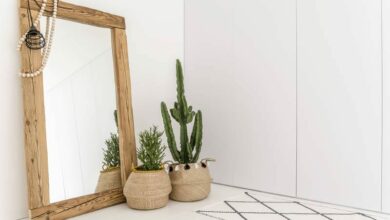Laminate vs. Vinyl Flooring


REDPIXEL.PL/ Shutterstock
Laminate and vinyl flooring are great alternatives to hardwood, stone, and tile when looking for cost-effective flooring solutions. Not only are they durable, but they are also characterized by easy installation and maintenance. When comparing laminate versus vinyl flooring, there are many factors to consider, including which rooms each floor works best in, the types of flooring available, and the benefits and costs of each. This guide provides an in-depth comparison of laminate versus vinyl flooring to help you decide which type of flooring is best for your project.
Laminate flooring
Learn all about laminate flooring, including what it is, what it’s best for, the different types of laminate flooring available, and the benefits and costs associated with them.
See offers
What is laminate flooring?
Laminate flooring is an economical, functional flooring option that works well and feels good underfoot. Laminate consists of four resin-coated layers: a top wear layer, a printed decorative layer, a fiberboard layer, and a backing layer, and comes in many styles that mimic natural wood and stone. While this product is scratch resistant and easy to clean, some homeowners find that moisture can easily cause it to swell and chip. Due to their efficient materials and manufacturing, laminate flooring is relatively inexpensive compared to other flooring products. Where to use laminate flooring. The best rooms to install laminate flooring they include high traffic rooms such as dining room, living room and family room. While hardwood will add value to your home, using laminate will mimic the look of this flooring with increased durability. You can find styles that look like maple, oak, stone, tile, and more. If you need to install laminate over an existing floor, its low profile design allows you to do so.
Types of laminate flooring
Laminate floors come in many styles to match your décor, plus glue and no-glue installations with interlocking planks (known as “floating flooring”) or a glue-backed layer. The glue option helps create a seal between the floorboards, which can be beneficial when installing in spaces where spills occur frequently, such as bathrooms and kitchens.
Laminate flooring benefits
Aside from being an inexpensive installation that looks remarkably realistic, laminate flooring has a great deal of other benefits, including its strength, scratch resistance and durability. You will also find that it is stain resistant, there is a wide range of styles available and it is a great option for those suffering from allergies.
Laminate flooring costs
The average total cost of a laminate flooring project ranges from $ 4 and $ 5 per square foot. Itemized, that means you can expect to pay between $ 2 and $ 3 per square foot for installation. The cost of average materials $ 1.50 per square foot, with subfloor prices averaging $ .30 per square foot. If you decide to do the installation yourself, you will simply need to factor in the costs of raw materials, along with any tools you will need to complete the project.
Vinyl flooring
Now, let’s take a look at vinyl flooring, including what it is, what it is best for, the types available, and their costs and benefits.
What are vinyl floors?
Vinyl flooring The manufacturing process involves synthetic materials that are made of PVC (polyvinyl chloride plastic). Flexible vinyl sheets develop when small pieces of PVC are subjected to extreme heat and pressed into thin layers. These planks can look and feel like a variety of materials, including ceramic tile, stone, and wood. It’s easy to confuse vinyl, linoleum, and laminate flooring because of their similarities. The difference is that the composition of vinyl flooring is completely synthetic, while linoleum and laminate have natural materials. That means vinyl is easier to install and costs less.
Vinyl floors are best for:
Vinyl flooring it is best for many rooms in your home, including hallways, kitchen, bathrooms, and laundry rooms. If you have an enclosed patio, vinyl flooring is also a great option for this area. Because vinyl will install on any surface, this material works well in basements too.
Types of vinyl flooring
exist three main types vinyl flooring, including vinyl plank, vinyl sheet, and peel and stick flooring. Beyond that, you also have three options regarding its structure and grade. These include deluxe vinyl planks, which are of higher quality than competitive styles due to their thickness and durability, WPC vinyl flooring, which is a waterproof option with a four-layer construction, and rigid core vinyl planks. , which feature a composite of stone and plastic. core that is great for high-traffic areas of your home.
Benefits of vinyl flooring
Vinyl flooring is easy to maintain, waterproof, comfortable on your feet, cost effective, and durable. You will also find it easy to install, and no matter where you install, you will benefit from the stain resistance of vinyl flooring.
Vinyl flooring costs
The price to install vinyl flooring is between $ 2 and $ 3 per square foot. The labor for the installation has the same cost range, between $ 2 and $ 3 per square foot. Again, if you choose to install the flooring yourself, you only need to consider the cost of raw materials, along with the necessary tools.
Laminate flooring vs vinyl
There are differences and similarities when comparing laminate and vinyl floors. The best thing to do is determine which room the installation will take place in, and then decide which material is best for that room. When comparing laminate to vinyl flooring, another consideration that can help you decide is whether or not you want to use synthetic or all-natural materials.
Frequent questions
Are vinyl and laminate the same? Vinyl flooring it is available in tiles or sheets; it is flexible and easy to maintain. Laminate flooring It is rigid, has interlocking edges, and does not need to adhere to the subfloor, whereas vinyl uses a self-adhesive backing or glue during installation. Both materials mimic the look of ceramic, wood and stone tiles. What is more durable, vinyl or laminate? While vinyl flooring is easier to install, laminate flooring is more durable. It is resistant to damage and ideal for high traffic areas and homes with children or pets. Are laminate or vinyl floors better for bathrooms? Laminate flooring is moisture, scratch and stain resistant and durable during heavy traffic, making it an excellent choice. You need a silicone seal around bathtubs and toilets to ensure that water doesn’t get underneath. Vinyl floors, specifically laminated vinyl, are a good option for bathrooms, as the peel and stick varieties can be susceptible to water leaks. Should I hire a professional to install my flooring? Depending on your level of experience, you can install laminate or vinyl flooring as a DIY project. If you are not sure how to measure the space and calculate the amount of material you will need, it is a good idea to hire a professional. Do you know if a subfloor It is necessary, regardless of whether or not an existing flooring is needed, how to cut the material and how to assemble the rows of boards correctly.





